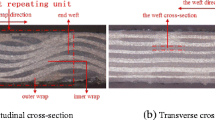Abstract
To model 3-Dimensional woven composites, the width and thickness of the yarn are generally used as input parameters. However, since these parameters can only be obtained after the composites are molded, it is not efficient in the initial stages of design using woven composites. Therefore, a geometric modeling method using weaving parameters that can be known before manufacturing is required. In this paper, geometric parameters such as thickness and width of each yarn are calculated using weaving parameters. From the obtained parameters, the cross section and path of the yarns and the unit cell are modeled. The method is validated by comparing the calculated geometric parameters and fiber volume fraction with direct measurements of the overall composite. Moreover, the unit cell is applied to an analytical method based on the iso-strain and iso-stress assumptions to evaluate the stiffness in the longitudinal and transverse directions. The mechanical properties are compared and verified with the specimen test results. We conclude that the present method is useful for the design of aerospace structures to which the 3-dimensional composite is applied.














Similar content being viewed by others
References
Ansar M, Xinwei W, Couwei Z (2011) Modeling strategies of 3D Woven composites: a review. Compos Struct 93:1947–1963. https://doi.org/10.1016/j.compstruct.2011.03.010
Marsh G (2012) Aero engines lose weight thanks to composites. Reinf Plast 56:32–35. https://doi.org/10.1016/S0034-3617(12)70146-7
Nathan S (2015) Positive reinforcement: 21st century 3D weaving. The Engineer
Luyker ED, Morestin F, Boisse P, Marsal D (2019) Simulation of 3D interlock composites preforming. Compos Struct 88:615–623. https://doi.org/10.1016/j.compstruct.2008.06.005
Byun JH, Chou TW (1990) Elastic properties of three-dimensional angle-interlock fabric preforms. J Textile Inst 81:538–548. https://doi.org/10.1080/00405009008658727
Naik RA, Jarmon DC, Logan CP (1998) Characterization and modeling of angle interlock woven composites (1998) 39th AIAA/ASME/ASCE/AHS/ACS Structures. Struct Dyn Mater Conf Exhibit. https://doi.org/10.2514/6.1998-1810
Wu ZJ, Brown D, Davies JM (2002) An analytical modeling method for predicting the stiffness of 3-D orthotropic laminated fabric composites. Compos Struct 56:407–412. https://doi.org/10.1016/S0263-8223(02)00024-7
Buchanan S, Grigorash A, Archer E, Quinn MA, Stewart JG (2010) Analytical elastic stiffness model for 3D woven orthogonal interlock composites. Compos Sci Technol 56:1597–1604. https://doi.org/10.1016/j.compscitech.2010.05.019
Zhou Y, Wen W, Cui H (2020) Spatial modeling of 3D woven variable thickness composite plate at the mesoscopic scale. Compos Struct 239:1–9. https://doi.org/10.1016/j.compstruct.2020.111946
Tan P, Long L, Steven GP (2000) Behavior of 3D orthogonal woven CFRP composites. Part II. FEA and analytical modeling approaches. Compos Part A 31:273–281. https://doi.org/10.1016/S1359-835X(99)00071-8
Desplentere F, Lomov SV, Woerdeman DL, Verpoest I, Wevers M, Bogdanovich A (2005) Micro-CT characterization of variability in 3D textile architecture. Compos Sci Technol 65:1920–1930. https://doi.org/10.1016/j.compscitech.2005.04.008
Green SD, Matveev MY, Long AC, Ivanov D, Hallett SR (2014) Mechanical modeling of 3D woven composites considering realistic unit cell geometry. Compos Struct 118:284–283. https://doi.org/10.1016/j.compstruct.2014.07.005
Isart N, Mayugo JA, Blanco N, Ripoll L, Sola A, Soler M (2015) Geometric model for 3D through-thickness orthogonal interlock composites. Compos Struct 119:787–798. https://doi.org/10.1016/j.compstruct.2014.09.044
Sherburn M (2007) Geometric and mechanical modeling of textiles. Doctoral Dissertation, University of Nottingham
Lin H, Zeng X, Sherburn M, Long A, Clifford M (2011) Automated geometric modeling of textile structures. Text Res J 82:1689–1702. https://doi.org/10.1177/0040517511418562
Dai S, Cunningham PR, Marshall S, Silva C (2015) Influence of fibre architecture on the tensile, compressive and flexural behavior of 3D woven composites. Compos Part A 69:195–207. https://doi.org/10.1016/j.compositesa.2014.11.012
Umer R, Alhussein H, Zhou J, Cantwell WJ (2016) The mechanical properties of 3D woven composites. J Compos Mater 51:1703–1716. https://doi.org/10.1177/0021998316681187
Wucher B, Hallstorm S, Dumas D, Pardoen T, Bailly C, Martiny PH, Lani F (2017) Nonconformal mesh based finite element strategy for 3D textile composites. J Compos Mater 51:2315–2330. https://doi.org/10.1177/0021998316669875
Farrokh B, Segal KN, Ricks TM, Miller SG, Rodini BT, Sleight DS (2019) Uniaxial tensile properties of AS4 3D woven composites with four different resin systems: experimental results and analysis—property computations. In: NASA Technical Reports
Yan S, Zeng X, Long A (2020) Effect of fibre architecture on tensile pull-off behavior of 3D woven composite T-joints. Compos Struct 242:1–9. https://doi.org/10.1016/j.compstruct.2020.112194
Siddgonde N, Ghosh A (2020) Thermo-mechanical modeling of C/C 3D orthogonal and angle interlock woven fabric composites in high temperature environment. Mech Mater 148:1–14. https://doi.org/10.1016/j.mechmat.2020.103525
Mehdikhani M, Gorbatikh L, Verpoest I, Lomov SV (2019) Voids in fiber-reinforced polymer composites: a review on their formation, characteristics, and effects on mechanical performance. J Compos Mater 53:1579–1669. https://doi.org/10.1177/0021998318772152
Kreger AF, Teters GA (1980) Use of averaging methods to determine the viscoelastic properties of spatially reinforced composites. Mech Compos Mater 15:377–383. https://doi.org/10.1007/BF00605861
Kalidindi SR, Franco E (1996) Longitudinal and transverse moduli and strengths of low angle 3-D braided composites. J Compos Mater 30:885–905. https://doi.org/10.1177/002199839603000802
Kalidindi SR, Franco E (1997) Numerical evaluation of isostrain and weighted-average models for elastic moduli of three-dimensional composites. Compos Sci Technol 57:293–305. https://doi.org/10.1016/S0266-3538(96)00119-4
Hallal A, Younes R, Fardoun F, Nehme S (2012) Improved analytical model to predict the effective elastic properties of 2.5D interlock woven fabrics composite. Compos Struct 94:3009–3028. https://doi.org/10.1016/j.compstruct.2012.03.019
Chamis CC (1983) Simplified composite micromechanics equation for hygral thermal and mechanical properties. In: NASA Technical Memorandum 83320
Rudov-Clark S, Mouritz AP, Lee L, Bannister MK (2003) Fibre damage in the manufacture of advanced three-dimensional woven composites. Compos Part A 34:963–970. https://doi.org/10.1016/S1359-835X(03)00213-6
Mehdikhani M, Steensels E, Standaert A, Vallons K, Gorbatikh L, Lomov SV (2018) Multi-scale digital image correlation for detection and quantification ofmatrix cracks in carbon fiber composite laminates in the absence and presence of voids controlled by the cure cycle. Compos Part B 154:138–147. https://doi.org/10.1016/j.compositesb.2018.07.006
Acknowledgements
This research is supported under the framework of Aerospace Technology Development Program (no. 10074270) funded by the Ministry of Trade, industry & Energy (MOTIE, Korea)
Author information
Authors and Affiliations
Corresponding author
Additional information
Publisher's Note
Springer Nature remains neutral with regard to jurisdictional claims in published maps and institutional affiliations.
Rights and permissions
About this article
Cite this article
Kim, H., Park, J. Improved Modeling Method for 3-Dimensional Woven Composites Using Weaving Parameters. Int. J. Aeronaut. Space Sci. 22, 824–833 (2021). https://doi.org/10.1007/s42405-021-00365-z
Received:
Revised:
Accepted:
Published:
Issue Date:
DOI: https://doi.org/10.1007/s42405-021-00365-z




